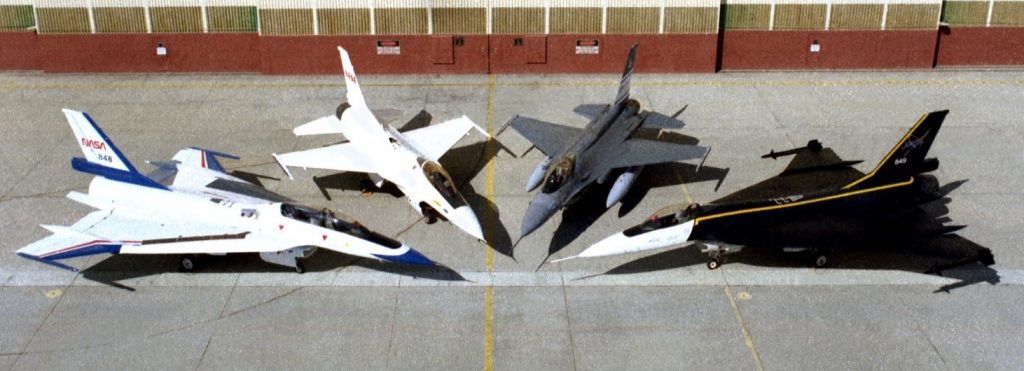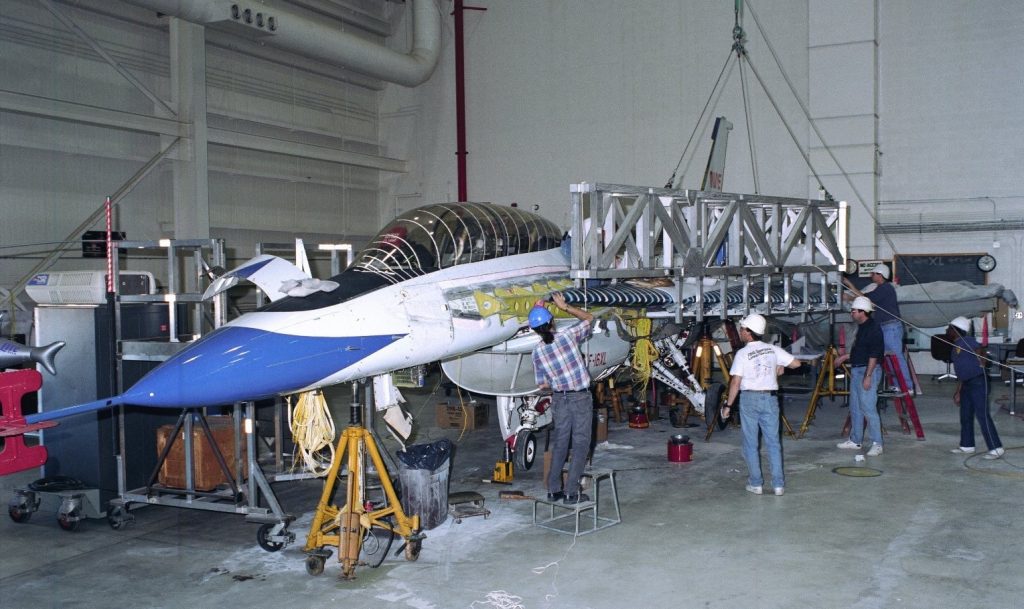Four different versions of the General Dynamics F-16 shared the ramp at NASA’s Dryden Flight Research Center at Edwards, California, in this 1997 photo. At left and right are the only two F-16XL prototypes built. The two-seat F-16XL-2 version to the left, NASA registration number 848, was flown in a supersonic active/passive laminar flow control experiment until late 1996. The single-seat F-16XL-1 at right, NASA registration number 849 (originally USAF 749), was flown in a variety of experiments, including an earlier passive laminar-flown study and sonic boom attenuation research. At center left is a single-seat F-16A, NASA registration number 816, the only civil registered F-16 in existence. At center right is the U.S. Air Force Advanced Fighter Technology Integration (AFTI) F-16A.
Silent NASA video, F-16XL-1 #849 in-flight 1992:
NASA 849 F-16XL-1 in earlier passive laminar flow experiment.
By 1993, F-16XL-1 #849 was returned to original configuration to study the performance of the XL’s ‘cranked arrow’ wing.
NASA 848 F-16XL-2 prior to active/passive laminar flow wing glove modifications. 848 was originally a single seat USAF F-16A #75-0747, which crashed at the end of 1980, was rebuilt as the first F-16XL in 1981, then rebuilt again as the two seat F-16XL-2 taking its first flight in 1982.
Mounting the perforated port ‘active’ laminar flow glove on #848.
This NASA photo shows you how tiny the perforations are in the port glove. The edge of a dime coin is used to show scale, NASA used a laser to drill the 10-million, almost microscopic, holes.
First flight of fully modified F-16XL #848. Notice the wing tip sensors, which were used to study ‘flutter’ on 848 prior to being modified for laminar flow testing. They were not used during the bulk of the laminar flow testing. This NASA video explains the use of the wing tip ‘exciter vanes’ (Excitation System) on 848:
A turbo-compressor vacuum mounted in the fuselage, behind the cockpit, draws off a small part of the boundary-layer air flowing over the port wing’s perforated titanium leading edge glove at supersonic speeds, this is known as Supersonic Laminar Flow Control, or active laminar flow system. The turbo compressor exhausts out the starboard side of the fuselage.
A turbo-compressor (looking like a axillary power unit, APU) in the aircraft’s fuselage provided suction to draw air through more than 10-million tiny laser-drilled holes in the titanium glove via a manifold system employing 20 valves.
In some photos you’ll notice a small canard, known as a ‘shock fence’, protruding from under the leading edge. In a few photos it’s not present.
Note that the leading edge on the starboard side is different.
The starboard leading edge was known as the passive laminar flow system.
NASA video, one hour of ‘raw’ (unedited) video of F-16XL-2 in flight:
Data obtained during the program was collected in the hopes of developing civilian transport aircraft (specifically Boeing, Rockwell, and McDonnell Douglas) that could cruise at supersonic speeds.
 WINGLETS, OR ONCE AGAIN NASA SAVES THE PRIVATE SECTOR!
WINGLETS, OR ONCE AGAIN NASA SAVES THE PRIVATE SECTOR!
















